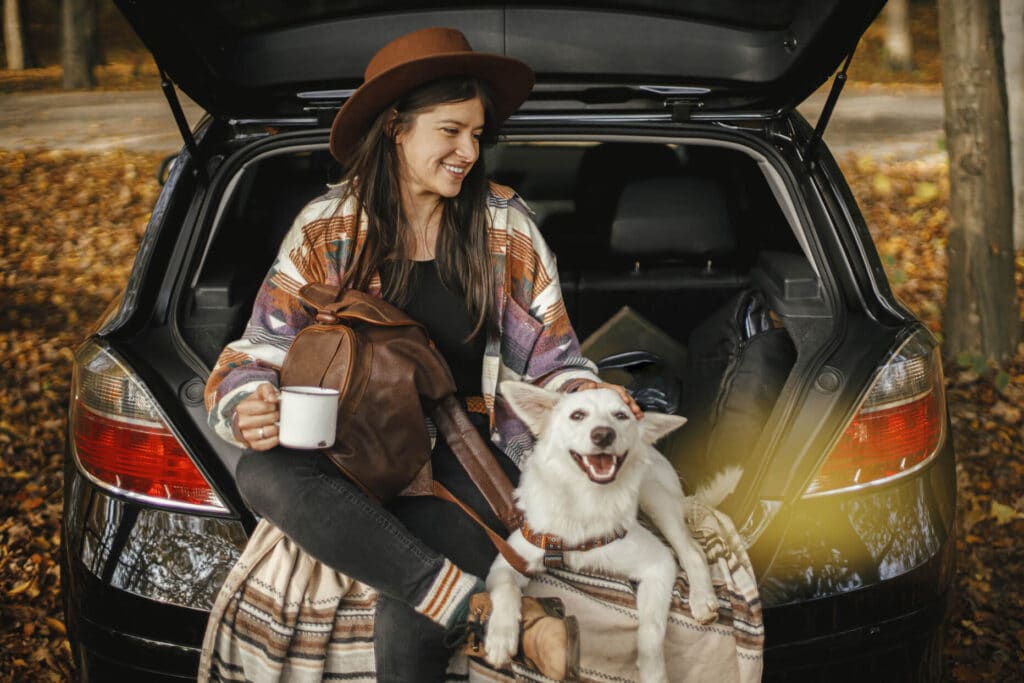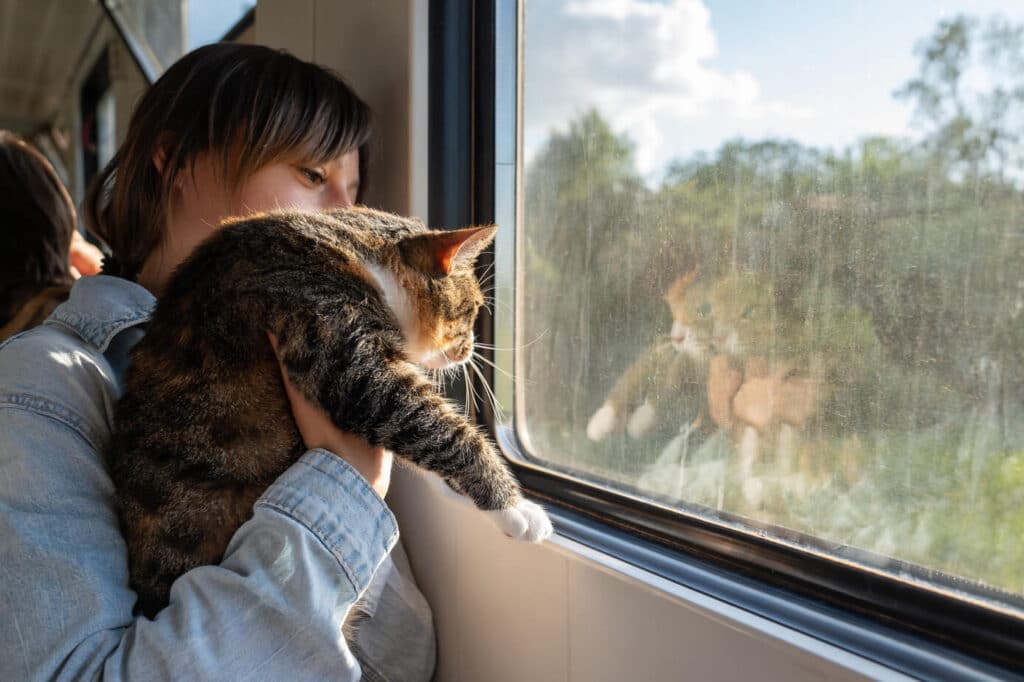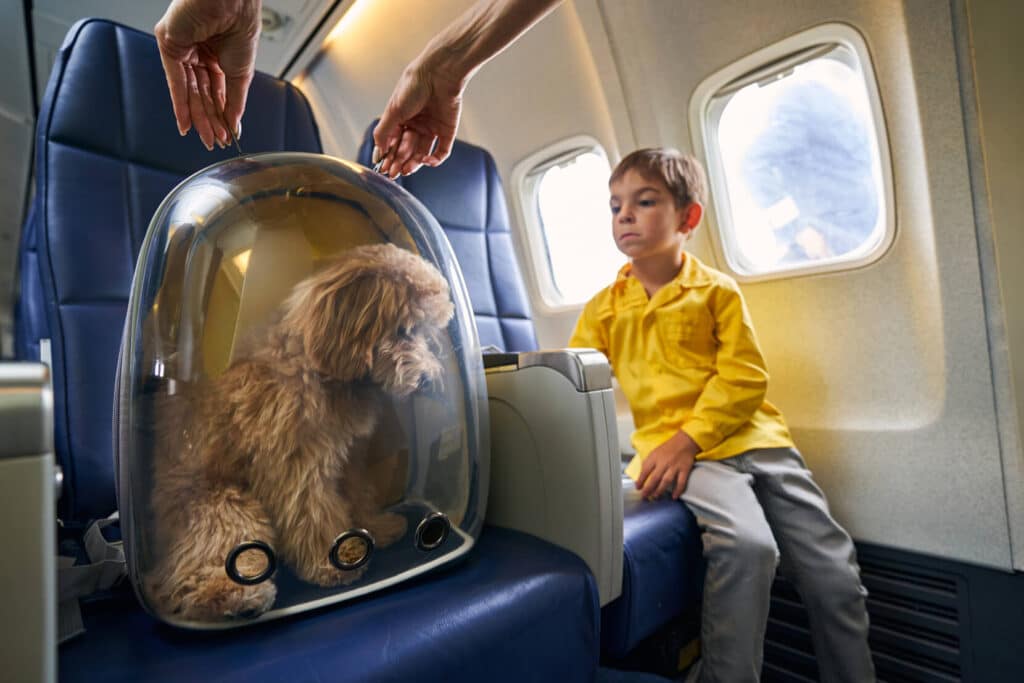Traveling with pets can be an amazing experience. Whether you’re hitting the open road with a furry friend, or something a bit scalier, prep is key. In this guide, we’ll walk through everything you need to know about traveling with pets, including how to make sure your pets are enjoying the journey as much as you.

General Prep To Travel By Land
Before you hit the road, preparation is key. Whether you’re planning a day trip or a cross-country journey, making sure you have the right documents, supplies, and travel setup will save you from unexpected surprises. Here’s what to keep in mind before you start your adventure.
Rules & Regulations
Every destination has its own set of requirements for pet travel. For domestic trips, check the specific regulations for each state or province.
Requirements usually include things like proof of vaccinations (especially rabies) which you should carry at all times. For international travel, health certificates issued by a vet within 10 days of departure are usually mandatory. If your pet isn’t already microchipped, consider doing so, as this is also requirement in many countries.
When traveling with exotic pets, the rules are even stricter. You’ll likely be required to have specific permits, and you’ll need to check both your current location’s and your destination’s regulations to avoid legal complications.
Packing Essentials
Packing the right items can turn a stressful trip into a breeze. Bring enough food and water to last the entire trip, plus a collapsible bowl for easy feeding and hydration. Comfort items like a favorite blanket, bed, or toy can also really help reduce your pet’s stress levels.
Safety should always be a priority. Pet-specific travel gear, such as seat belts, harnesses, or crates, ensures they are secure during the journey. Additionally, pack a first-aid kit with bandages, tweezers, and medications your pet might need, as well as cleaning supplies like waste bags or a portable litter box.
Safety During The Trip
A loose pet in a moving vehicle can be dangerous for both you and your furry friend. Always secure your pet in a harness, crate, or carrier designed for travel. Keep the car well-ventilated, and never leave your pet unattended in a parked vehicle, especially during extreme weather. For nighttime travel, consider reflective collars or leashes for extra visibility.
Traveling By Bus/Train/Car With Dogs & Cats
Dogs and cats are among the most common travel companions, and road trips can be particularly enjoyable for them. But without the right setup and approach, even short drives can become stressful. Here’s how you can ensure a comfortable journey for you and your furry friend.

Setting Up Your Vehicle
Transforming your car into a pet-friendly space starts with organization. Seat covers or waterproof pet hammocks can protect your car’s interior while giving your pet a cozy place to rest. For larger dogs, a rear-seat barrier can prevent distractions while keeping them safely confined.
Keeping Stress Levels Down
Long car rides can be challenging, especially if your pets are unfamiliar with travel. Begin with short trips to help them acclimate to the car. During the journey, keep them entertained with interactive toys or chew treats. If your pet tends to get anxious, calming aids such as pheromone sprays or vet-prescribed medications can make a significant difference.
Keeping Your Car Clean
One of the biggest challenges of traveling with pets in the car is keeping everything clean. Whether it’s shedding fur, muddy paws, or accidental spills, the right preparation can help you maintain a clean and comfortable vehicle throughout your journey.
- Seat Covers and Blankets: Waterproof seat covers or pet-specific blankets are a must for protecting your car’s seats. These are easy to remove and wash if your pet gets dirty or sheds too much fur.
- Portable Lint Rollers and Vacuums: Keep a portable lint roller handy to quickly remove pet hair from upholstery. A small handheld vacuum can also help you clean up after your pet during stops.
- Pet Travel Bags: Use a travel bag for your pet that includes built-in compartments for waste bags, cleaning wipes, and extra towels. This makes it easier to clean up messes on the go.
- Paw Cleaning Supplies: To avoid mud and dirt from getting inside the car, pack some paw cleaning supplies. Use a portable paw washer or simply carry wipes to clean your pet’s paws before they jump into the car.
- Accidents and Spills: Accidents happen, especially with nervous pets. Pack absorbent pads or a small towel to cover any mess. If necessary, keep a disinfectant or pet-safe cleaner on hand to deal with spills quickly.
Traveling By Bus or Train
Traveling by bus or train with pets can be an economical and environmentally friendly option, but it does require careful planning. Not all bus or train companies allow pets, so research and choose one that has a pet-friendly policy. Some carriers may only permit small pets in carriers, so be sure your pet’s crate meets the size and ventilation requirements set by the company.
Before booking, check if the route includes stops where you can take your pet out for a quick break. You should also keep in mind that noise and motion can be stressful for pets on a bus or train. So consider bringing a blanket to help them feel secure. For longer journeys, pack extra food, water, and waste bags, and be mindful of fellow passengers who may have allergies or fears of animals.

Border Crossing
Crossing borders with pets can be seamless with the right preparation. Ensure all vaccination records and health certifications are up-to-date and accessible. Research pet-friendly rest stops along your route and plan for regular breaks. Keep your pet leashed and supervised during stops to ensure their safety.
Traveling With Exotic Pets
Traveling with exotic pets like snakes, lizards, or birds can be more complex, but it’s entirely possible with the right approach. These unique companions require specific conditions to remain safe and comfortable on the road. Here’s how to ensure their well-being during your journey.
Essentials
Exotic pets like snakes, reptiles, or birds need specialized care during travel. Their enclosures have to be secure, escape-proof, and provide adequate ventilation. For reptiles, maintaining a consistent temperature is critical; heat packs or portable heaters can help during colder weather. For birds, partially covering their cage can reduce stress while ensuring sufficient airflow.
Tips For Traveling With Reptiles
Transport your reptile in an enclosure that mimics their home environment as much as possible. Avoid feeding them immediately before travel to prevent regurgitation caused by stress. Always monitor for signs of distress, such as unusual movements or lethargy, and adjust their environment accordingly.
Tips For Traveling With Birds
Birds are sensitive to changes in their surroundings, so choose a travel cage that provides both security and comfort. Line the cage with absorbent material to simplify cleanup. Include familiar toys or perches to give your bird a sense of normalcy. Speaking gently to your bird can also help keep them calm during the trip.
Legal Considerations
Regulations for exotic pets vary widely. Some species may require CITES (Convention on International Trade in Endangered Species) permits for cross-border travel. Always check with local authorities before your trip to ensure compliance with all legal requirements.

What About Air Travel?
Air travel requires extra preparation, but it’s often the fastest way to reach your destination. If you’re flying with a pet, familiarize yourself with airline policies, documentation requirements, and packing tips.
For more details, take a look at our guides on flying with pets on American airlines, and our guide to flying with pets on European airlines.
Tackling Common Travel Challenges
Even the best-laid plans can hit road bumps when traveling with pets. From motion sickness to unforeseen emergencies, being prepared for common challenges ensures you can handle them calmly and effectively. Here’s how to tackle some of the most frequent issues pet owners face on the road.
Motion Sickness
Motion sickness can affect any pet, but it’s most common in dogs. However, reptiles and birds can also experience stress and discomfort from the motion of the vehicle. Here’s how to minimize the risk:
- Dogs and Cats: Avoid heavy meals just before travel to prevent nausea. Use calming aids like ginger treats or medications recommended by your vet.
- Birds: Birds are sensitive to motion and may become disoriented or stressed. Keep their carrier secure and covered partially to reduce the sensation of movement. Avoid placing them near windows where they can see the rapid changes in scenery.
- Reptiles: Snakes and reptiles are less likely to suffer from motion sickness in the traditional sense, but they can become stressed from the confined space or temperature fluctuations. Keep them in well-ventilated containers with stable temperatures to avoid stress.
Restlessness & Anxiety
Whether it’s your dog pacing in the back seat or your parrot calling out loudly, pet anxiety is common on long journeys. Here’s how to keep them calm:
- Dogs and Cats: Frequent breaks every 2-3 hours can help your pet relieve themselves and stretch. Bring their favorite toy or blanket for added comfort. Calming products like sprays or collars can also help reduce anxiety.
- Birds: Birds are often more sensitive to the noise and movement of travel. Keep their carrier in a quiet, secure spot in the vehicle, and cover it with a light cloth to create a calming, darkened environment. Avoid loud sounds or sudden movements that might startle them.
- Reptiles: While reptiles tend to be less affected by anxiety, a stable environment is crucial. Ensure their container is secure and not overly jostled during the journey. Avoid excessive handling, as this can stress them out further.

Emergencies
Being prepared for emergencies is essential when traveling with any pet, especially exotic ones. Here’s how to be ready:
- Dogs and Cats: Keep a well-stocked first-aid kit and know where the nearest vet is along your route. Make sure you have up-to-date vaccination records and health certifications.
- Birds: In case of injury or illness, ensure you have the contact information for an avian vet or a general emergency clinic. Pack basic supplies like extra food, water, and a bird-safe travel cage that can be easily sanitized.
- Reptiles: For reptiles like snakes, a minor injury or stress-related illness can escalate quickly. Keep their care sheet handy, as different species have specific needs. A first-aid kit for reptiles should include items like antiseptic wipes and a small heat pad in case of temperature drops.
Unexpected Delays
Delays can be stressful for both you and your pets, but with a bit of preparation, you can keep the trip on track:
- Dogs and Cats: Have extra food, water, and waste bags on hand. Stick to your pet’s regular feeding and bathroom schedule as much as possible.
- Birds: Keep your bird’s cage secure and stable during delays. Bring extra food and water, and try to keep their environment as calm as possible. If you’re stopped for long periods, try to shield their carrier from too much noise.
- Reptiles: For reptiles, long delays can be particularly difficult if their temperature isn’t properly regulated. Pack a portable heat pack and keep their enclosure as stable as possible. Ensure they have enough space to stay comfortable during unexpected stops.
Environmental Challenges
Changing climates and environments can be challenging for all pets, especially those with specific habitat needs:
- Dogs and Cats: If you’re traveling in extreme heat or cold, take extra precautions. Never leave your dog in a hot car, and ensure they have plenty of water to stay hydrated. In cold weather, ensure your pet is bundled up for warmth.
- Birds: Birds are highly sensitive to temperature fluctuations. Keep their environment at a stable temperature, and avoid exposing them to extreme heat or cold. Be mindful of humidity, as birds require a certain level to remain comfortable.
- Reptiles: Reptiles like snakes are cold-blooded, which means they rely on external sources to regulate their body temperature. Make sure their travel container has a heat source if traveling in cold conditions. Similarly, keep their container in a cool, shaded area if traveling in heat to avoid overheating. If you’re in a car, use portable heating pads designed for reptiles.











